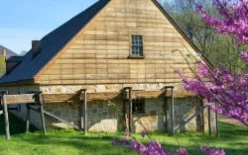In January 1797, James Anderson, Mount Vernon’s new farm manager from Scotland, proposed that George Washington begin rye and corn whiskey production. Although Washington was looking forward to a quiet retirement from the presidency and claimed to know nothing of the business, he was convinced by Anderson's expertise and by the expansive potential market place for whiskey.

Washington ordered a stone still house and a small malt house to be built adjacent to the gristmill on Dogue Creek, about two miles from the Mansion. The still house was furnished with five copper stills, boilers, and tubs. Wooden troughs were constructed to channel water from the creek to cool the vapor of the heated mash.
Washington attempted to persuade Anderson to choose a site closer to the Mansion in order to keep a closer eye on the distillery, fearing theft.1 Washington was later convinced that the distillation process made proximity to water crucial. The busy complex on Dogue Creek included a substantial merchant mill, a distillery, a cooper's shop, the miller's house, and livestock pens, all located on the main road to Alexandria or to points south. Recognizing the area as Mount Vernon's economic center, Anderson requested to relocate his residence to the center of activity.

By the spring of 1798 the distillery was in operation. In 1799—the year of Washington's death—over eighty transactions are noted for a total sale of 10,942 gallons of whiskey, valued at $7,674. Customers listed included neighboring farmers, merchants, family, and Mount Vernon overseers. Whiskey was also exchanged for services in the case of family physician James Craik and the farm overseers, and for goods such as corn and rye, which would then be converted into whiskey.2
As with his mill, Washington processed the harvests from his own farms but purchased grain from outside sources as well. Washington was clearly not interested in simply supplying the needs of those on his property, but considered the enterprise to be a thriving moneymaker. Enslaved distillers such as Hanson, Peter, Nat, Daniel, James, and Timothy labored making the whiskey. The distillery also offered an important subsidiary benefit. Livestock, particularly hogs, were fattened with the leftover cooked mash.3
In 1798, Polish visitor Julian Niemcewicz toured the site and noted: "If this distillery produces poison for men, it offers in return the most delicate and the most succulent feed for pigs. They keep 150...of the Guinea type, short feet, hollow backs and so excessively bulky that they can hardly drag their big bellies on the ground. Their venerable and corpulent appearance recalled to me our Dominican convents, like so many priors."4 The notoriety of the distillery in such a brief time and Washington’s interest in maintaining it demonstrated his growing interest in diversifying production at Mount Vernon towards the end of his life.
Notes:
1. “From George Washington to James Anderson, 8 January 1797,” Founders Online, National Archives.
2. “From George Washington to James Anderson, 11 June 1798,” Founders Online, National Archives; “From George Washington to James Anderson, 10 September 1799,” Founders Online, National Archives.
3. “To George Washington from James Anderson, 22 February 1797,” Founders Online, National Archives; “From George Washington to John Fitzgerald, 12 June 1797,” Founders Online, National Archives.
4. Niemcewicz, Julian Ursyn. Under Their Vine and Fig Tree: Travels through America in 1797-1799, 1805, ed. by Metchie J. E. Budka. Elizabeth, New Jersey: New Jersey Historical Society by the Grassmann Publishing Company, Inc., 1965, 100.
Bibliography:
Niemcewicz, Julian Ursyn. Under Their Vine and Fig Tree: Travels through America in 1797-1799, 1805, ed. by Metchie J. E. Budka. Elizabeth, New Jersey: New Jersey Historical Society by the Grassmann Publishing Company, Inc., 1965, 100.
Pogue, Dennis J. Founding Spirits: George Washington and the Beginnings of the American Whiskey Industry. Buena Vista, VA: Harbour Books, 2011.
Pogue, Dennis. "Drink and Be Merry: Liquor and Wine at Mount Vernon," Dining with the Washingtons, Ed. Stephen A. McLeod. Chapel Hill: University of North Carolina Press, 2011.
Ragsdale, Bruce A., Washington at the Plow: The Founding Farmer and the Question of Slavery. The Belknap Press of Harvard University Press, 2021.

Washington's Distillery
Learn more about George Washington's distillery at Mount Vernon at our Distillery page.

